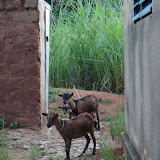
Warning: This blog post contains graphic gastro-intestinal details of life as a Peace Corps volunteer in Africa. Please continue reading at your own risk and if at any time you experience nausea, light headedness or general discomfort, please exit your browser and step away from the computer.
Of all the countries in which Peace Corps serves, Burkina Faso has earned the dubious honor of ranking high on the list of annual diarrhea cases. Hundreds of cases are reported each year by volunteers in Burkina and countless more are self-treated and go unreported. With the help of this blog, all of my cases which carry an interesting tale will be reported.
Those of you who know me well have probably heard some of my gastro-intestinal tales from the U.S. Just imagine what can happen when you’re living in a country that’s #1 for #2…
Before I begin, let me enlighten you with some G.I. basics. There are three main causes of diarrhea: parasites (giardia, amoeba), bacteria (E. Coli, Salmonella), and viruses. The typical transmission mechanism for these three causative agents is fecal-oral. I know that doesn’t sound appetizing, but there is a reason for the high rates of transmission. In Burkina, flush toilets are a rare luxury and in village, even latrines can be uncommon. Villagers (especially children) typically do their business just about anywhere. In fact, one of my first sights in Burkina was a small child “popping a squat” in a dusty field while I was eating breakfast. The ubiquitous fly is the most common vector since it carries the disease from the fresh pile of poo baking in the sun directly to your Coke bottle or plate of rice. Wind can also carry dirty dust particles into food and drink.
Luckily, our health care as volunteers is among the best in the world. When a volunteer comes down with a persistent case of diarrhea, a stool sample (a.k.a. MIF kit) is sent to the lab for diagnosis. Depending on the cause (parasite, bacteria, virus), medicine is prescribed and, boom, problem solved. However, trying to aim a “sample” into a quarter-sized opening can be challenging, even for the most adept poopers. And it is here where my story begins.
During training, I had pleasure of being able to complete two MIF kits. The first (giardia!) was rather uneventful. I simply used the “wrap hand in toilet paper, catch, and spoon into vial” method, and I prided myself on the execution. Success with the second MIF Kit, though, proved more elusive.
Since my first collection went so well, I attempted to use the same technique. I readied myself, hand wrapped in toilet paper, for the big catch with the same level of anticipation that I imagine an outfielder experiences during the World Series. I lined up and released. I was impressed with my aim (my eye-hand-ass coordination must come from years of playing video games as a child?) as it was a direct hit. Unfortunately, there was another variable I hadn’t considered: liquidity.
This was nothing like the first sample – it was pure liquid evil and catching any was impossible. What actually hit the toilet paper simply soaked through to my hand, leaving nothing to spoon into the vial. I had to find another way, but how? Since my hand was already quite messy, I decided it was time to go for broke and attempt a direct shot into the quarter-sized opening. The task was rather difficult given that the vial opening was 1/20th the size of the previous target and my hand was playing backup. I considered “McGyver-ing” an elaborate mirror system to assist, but there was no time. I simply aimed and fired. It felt as if I was playing the circus game in which one squirts water into the clown’s mouth. I produced enough “sample” to cover my hand and fill the vial. The sad part of it was there was no carnival worker to give me a prize for my efforts.
Then I began the arduous task of cleanup. Luckily this adventure occurred in our host family’s bathroom, a rare treat as it contained a shower, sink, and toilet. Even better, they were basically on top of one another, so I simply turned on the shower and washed the entire room, the vial, and myself. The next day I handed my hard-earned sample over to an employee at a bus station in Ouagadougou for a doctor to pick up and examine. If only that employee knew what was in the bag he was holding. My diagnosis this time? Bacterial infection.
Sidenote: If the creators of stool vials happen upon this blog, please start emulating the beverage industry and make wide-mouth bottles!
Disclaimer: If you enjoyed a real African story such as this one, I already have more! If you found this post disturbing and can take no more, please leave a comment to that effect.





